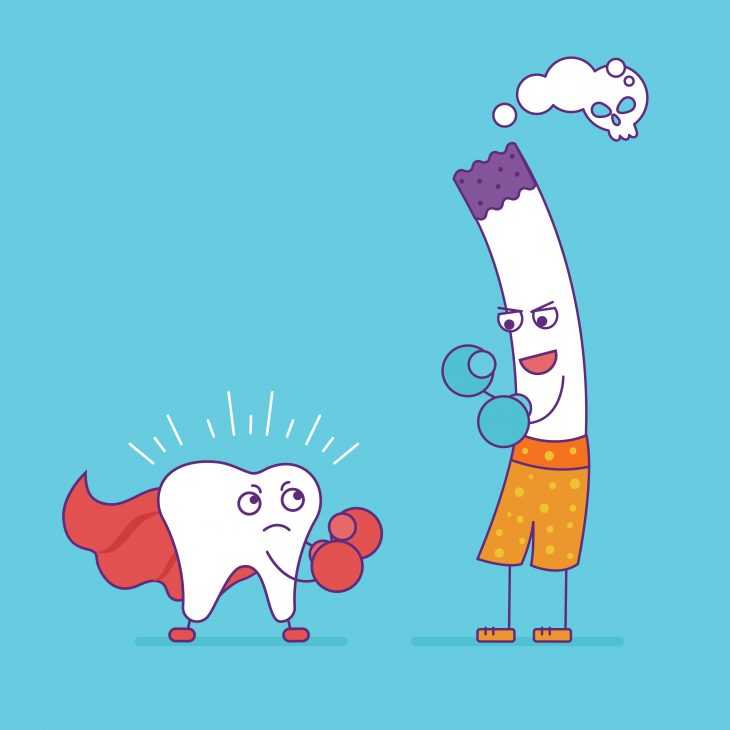Nicotine Stomatitis: What Is The Relation in Between?


Table Of Contents
What Is Stomatitis?
Stomatitis is an inflammation of the inside part of the mouth. It can affect all parts of the mouth, lips, cheeks, gums, tongue and the palates. Stomatitis is characterized by redness and swelling on the affected areas inside the mouth. It can cause discomfort and pain and in some severe cases can cause bleeding.
The three most common types of stomatitis are:
- Herpes stomatitis (cold sores)
- Aphthous stomatitis (canker sores)
- Nicotine stomatitis
How Are Nicotine And Stomatitis Related?
Nicotine and stomatitis are related because smoking can cause a condition known as nicotine stomatitis. Nicotine stomatitis is different from other forms of stomatitis since it mostly affects just the upper palate of the mouth and is caused primarily by heavy smoking.
The other kinds of stomatitis have different causes. Herpes stomatitis (cold sores) is caused by the herpes simplex 1 virus (HSV-1) and aphthous stomatitis (canker sores) has many different causes, which vary from poor hygiene to allergic reactions.
Causes
The causes of nicotine stomatitis are:
- Chronic pipe, cigar and cigarette smoking
- Reverse cigarette smoking
- High concentrations of heat hitting the roof of your mouth
- Chemical irritants
- Chronic drinking of hot liquids combined with smoking
Risk Factors
You are most at risk of developing nicotine stomatitis if you:
- Are a longtime smoker of pipes and cigars
- Are male
- Reverse smoke (put the lit end in your mouth)
Signs of Nicotine Stomatitis
Most cases of nicotine stomatitis include:
- Gray or white patches on the skin of the palate
- Red or white dots begin to appear when the salivary glands are inflamed
- Severe cases include a “dried lake-bed” look, which is caused by fissures in the mucous membrane
FAQ: Nicotine Stomatitis
-
Are There Other Ways I Can Get Nicotine Stomatitis?
Other than smoking tobacco products, there are no other ways to get nicotine stomatitis. Nicotine stomatitis does not occur from taking other forms of nicotine, like chewing gums and patches or e-cigarettes. The combination of heat and smoke that is unique to smoking tobacco products like pipes and cigars are the main factors that cause nicotine stomatitis.
-
Is Nicotine Stomatitis Dangerous?
Nicotine stomatitis is not dangerous. Some smokers do not even know that they have nicotine stomatitis. Aside from the inflammation and the lesions it causes, there are no symptoms associated with nicotine stomatitis. It does not cause pain or lead to any other medical conditions. It is, at worst, mildly irritating.
-
Does Nicotine Stomatitis Cause Cancer?
Nicotine stomatitis does not cause cancer, neither is it a type of cancer. However, in cases of reverse smoking, where the lit end of a cigarette is put into the mouth (which is a common practice in Southeast Asia and China) the lesions that appear can sometimes carry the risk of transforming into cancer.
Prevention
The best way to prevent getting nicotine stomatitis is to stop smoking. Other ways to prevent nicotine stomatitis:
- The majority of cases that involve nicotine stomatitis come from people who are regular pipe or cigar smokers, so you might consider smoking cigarettes instead or trying some form of nicotine replacement therapy or even using vapes, for a while.
- If you are a reverse cigarette smoker, nicotine stomatitis could lead to more serious afflictions, so try smoking cigarettes from the filter.
- Some people who wear dentures and smoke do not develop nicotine stomatitis under the area covered by their dentures, but they do develop it in the parts of the mouth not covered by their dentures.
Treatments
If you are showing signs of nicotine stomatitis, don’t panic. Nicotine stomatitis is not a serious or life-threatening affliction. You should stop smoking for a few weeks and the lesions on the upper palate of your mouth will disappear, even if you have had nicotine stomatitis for a long time. If you have stopped smoking but the lesions are still present, you should go see a doctor, since that would be a sign of something more serious.
Conclusion
There are a lot of dangers associated with smoking: strokes, heart attacks, cancer. Nicotine stomatitis is a less serious condition that will cause mostly discomfort but it is not life-threatening. If you are worried about developing nicotine stomatitis then you should check the inside of your mouth regularly, not only as a way to detect nicotine stomatitis but to check if you have any other major conditions as well.

Comments
Leave a comment